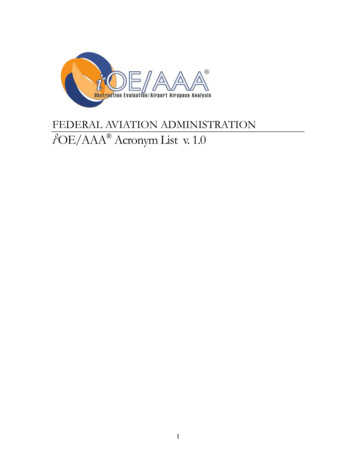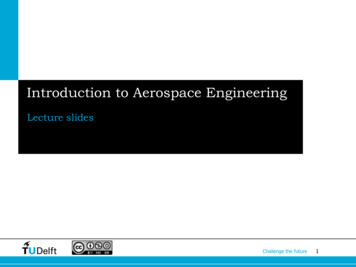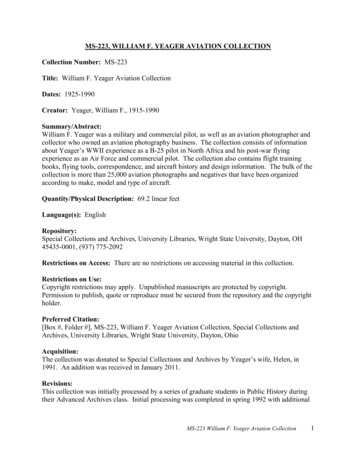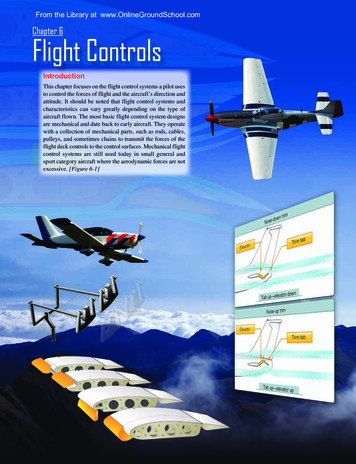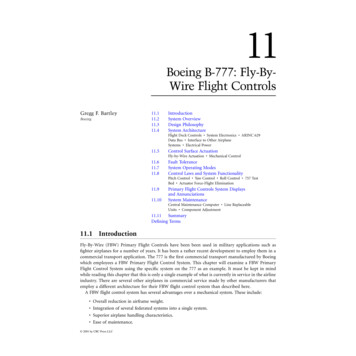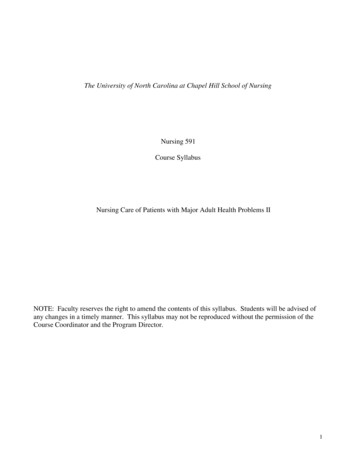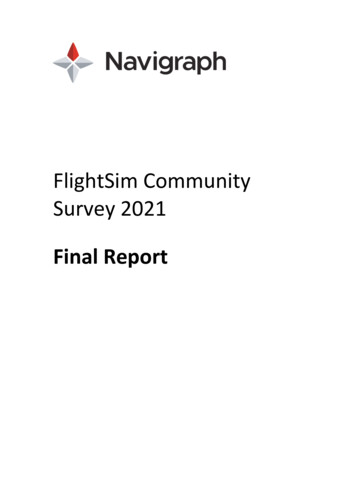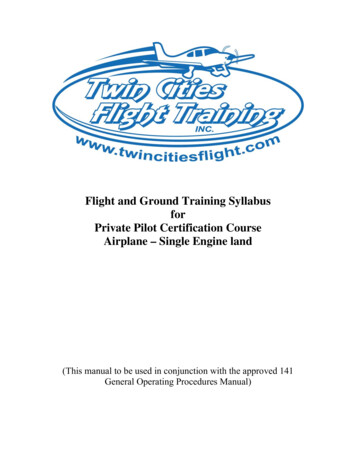
Transcription
Flight and Ground Training SyllabusforPrivate Pilot Certification CourseAirplane – Single Engine land(This manual to be used in conjunction with the approved 141General Operating Procedures Manual)
Flight and Ground Training SyllabusFAA Part 141 #W8LS876KPrivate Pilot - AirplaneTwin Cities Flight Training, Inc. 8891 Airport Road, Blaine, MN 55449Hangar row 2141 Rhode IslandFlight and Ground Training Syllabus Revision RecordRevision #DatePage NumbersRevision 18-15-2009Pg 1 Revision RecordRevision 18-15-2009Revision 18-15-2009Pg 1 Student Flight &Ground RecordPg 2 Flight & GroundTraining SyllabusRevision - 18-15-2009Initials
Flight and Ground RecordFAA Part 141 #W8LS876KPrivate Pilot - AirplaneTable of ContentsRecord of RevisionEnrollment CertificateGraduation CertificateStudent Ground and Flight Training RecordCourse TitleStudent EligibilityCourse ObjectivesCompletion StandardsClassroom and EquipmentAdditional Training AidsFurther Suggested ReadingPrimary Airport FacilitiesTraining AircraftChief Flight InstructorFlight InstructorsGround InstructorsCourse Time Allocation TableGround Training Course OutlineGround Training Course ObjectivesGround Training Course Completion StandardsInitial CertificationFlight Training Course OutlineFlight Training Course ObjectivesFlight Training Course Completion StandardsInitial CertificationRevision - Original9-1-20071
Flight and Ground RecordFAA Part 141 #W8LS876KPrivate Pilot - AirplaneTo be used in conjunction withStudent Flight and Ground RecordPrivate Pilot AirplaneCompleted(Date)1.Copy of student pilot license, drivers license and Medical2.TSA requirements met (Birth certificate & Photo ID, Naturalization papers, Passport)3.Issue Enrollment Certificate4.Able to conduct pre-flight inspections unassisted5.Able to safely conduct Engine Start and Engine Shut Down unassisted6.Stage One Written Exam – Ground7.Stage Two Written Exam – Ground8.Stage Three Written Exam – Ground9.Stage One Practical Exam – Flight10. Pre-Solo Written Exam11. FAA Written Exam completed12. Stage Two Practical Exam – Flight13. Stage Three Practical Exam – Flight14. Logbook endorsements completed15. All FAR Private Pilot requirements met16. 8710-1 completed prior to scheduling FAA Oral/Practical Exam17. Graduation Certificate Issued Revision - 1 8-15-20091
Flight and Ground RecordFAA Part 141 #W8LS876KPrivate Pilot - AirplaneIncomplete Lesson / Review SheetStudent name: Lesson #Notes:Instructor Signature: Date:Revision - Original9-1-20072
Flight and Ground Training SyllabusforPrivate Pilot Certification CourseAirplane – Single Engine LandGround Instruction35 HoursFlight InstructionDual24 HoursSolo11 HoursTotal 35 Hours
Flight and Ground Training SyllabusFAA Part 141 #W8LS876KPrivate Pilot - AirplaneCourse TitlePrivate Pilot Certification Course, Airplane – Single Engine Land. This training courseoutline meets all of the curriculum requirements for the Private Pilot Airplane SingleEngine Land certification course contained in 14 CFR FAR Part 141.55.Student EligibilityStudent enrollment for Ground Training is not age limited. However, the student must beable to read, speak, write, and understand the English language. To be eligible for FlightTraining, the student must hold a Student Pilot / Medical Certificate. To graduate fromthe course and to be eligible for their Private Pilot Certificate, the student must be at leastseventeen (17) years of age.Course ObjectivesThe student shall endeavor to obtain the aeronautical knowledge, skill and experiencenecessary to meet the requirements for the Private Pilot Certificate with a Airplanecategory – Single Engine Land rating. This syllabus is to be used as a guide. The timelisted for each lesson, ground or flight, is the minimum time required. The flight lessonsmay consist of more than one flight due to weight & balance considerations or studentschedules. Lessons within a stage are not requires to be given in exact order but shouldbe followed as closely as weather and student schedules permit.Completion StandardsThe student shall demonstrate that s/he meets the FAA Practical Test Standards bysatisfactory completion of a written knowledge exam, an oral exam, a flight review andappropriate documentation compiled by Twin Cities Flight Training, Inc., that the studenthas the necessary aeronautical knowledge, skill, and experience necessary to meet therequirements to obtain a Private Pilot Certificate with a Airplane - Single Engine Landrating.Additional Training Aids / Materials1. Course Syllabus2. Aircraft Flight Manual (POH)3. Jeppesen Private Pilot training manual4. FAR/AIM book5. Private Oral Exam Guide6. Private Pilot Test Prep Guide7. Flight Computer E6B8. Plotter9. Personal LogbookRevision - Original9-1-20071
Flight and Ground Training SyllabusFAA Part 141 #W8LS876KPrivate Pilot - AirplaneFurther Suggested Reading1. Pilot’s Handbook of Aeronautical Knowledge2. Airplane Flying Handbook3. Aviation Weather Services AC 00-45D4. Aviation Weather AC 00-6A5. The Pilot’s Radio Communication Handbook (Practical Flying Series)6. Avoiding Common Pilot Errors7. Aeronautical Chart User’s GuidePrimary Airport Facilities All Part 141 training flights will originate from the Anoka/Blaine (ANE) or DowntownSt. Paul Airport (Holman Field)(STP). Fuel and maintenance are available during allscheduled training flights. Both airports meet the requirements of 14 CFR FAR Part141.38 for day and night operations.Training AircraftAll aircraft meet the requirements of 14 CFR FAR Part 141.39. The aircraft are equippedfor day and night VFR as specified in 14 CFR Part 91.205.Chief Flight InstructorThe Chief Flight Instructor designated for this course must meet the qualifications listedin 14 CFR FAR Part 141.35(b). The Chief Flight Instructor is listed in Twin Cities FlightTraining, Inc Part 141 General Operating Procedures Manual Appendix A.Assistant Chief Flight InstructorThe Assistant Chief Flight Instructor designated for this course must meet thequalifications listed in 14 CFR FAR Part 141.36. The Assistant Chief Flight Instructor islisted in Twin Cities Flight Training, Inc Part 141 General Operating Procedures ManualAppendix A.Flight InstructorsEach Flight Instructor assigned to this course must be the holder of at least a CertifiedFlight Instructor certificate and a Commercial Pilot Certificate with an Airplane Categoryrating and a Single Engine Land Class rating.Revision - 18-15-20092
Flight and Ground Training SyllabusFAA Part 141 #W8LS876KPrivate Pilot - AirplaneLesson Time AllocationGround Stage I, II and Flight Stage I222221.0.52221.0AsReq1.0161.02.0.51.0Ground Lesson 1 – Discovering AviationGround Lesson 2 – Airplane SystemsFlight Lesson 1Ground Lesson 3 – AerodynamicPrinciplesFlight Lesson 2Ground Lesson 4 – The FlightEnvironmentFlight Lesson 3Ground Lesson 5 – Communication andFlight InfoFlight Lesson 4Ground Lesson 6 – Stage I ExamFlight Lesson 5Ground Lesson 7 – Meteorology forPilotsFlight Lesson 6Ground Lesson 8 – Federal AviationRegulationsFlight Lesson 7Ground Lesson 9 – Interpreting WeatherDataPresolo Written Exam and .2)Flight Lesson 8Flight Lesson 9Ground Lesson 10 – Stage II ExamFlight Lesson 10 – Stage Check1.0Stage Totals9.0Revision - Original9-1-20073.5(1.0)Day Cross-CountrySoloDay LocalInstrumentNight Cross-CountryNight LocalDay LocalDay Cross-CountryFlight TrainingDualExam DebriefingStage/Final ExamsPilot BriefingsClass DiscussionGround Training
Flight and Ground Training SyllabusFAA Part 141 #W8LS876KPrivate Pilot - AirplaneLesson Time AllocationDay Cross-CountrySoloDay LocalInstrumentNight Cross-CountryNight LocalDay LocalDay Cross-CountryFlight TrainingDualExam DebriefingStage/Final ExamsPilot BriefingsClass DiscussionGround TrainingGround Stage III and Flight Stage II2.02.02.02.01.0.51.53.08.01.04.01.01.5Ground Lesson 11 – AirplanePerformanceFlight Lesson 11Ground Lesson 12 – NavigationFlight Lesson 12Ground Lesson 13 – Human FactorPrinciplesFlight Lesson 13Ground Lesson 14 – Flying CrossCountryFlight Lesson 14Ground Lesson 15 – Stage III ExamFlight Lesson 15Flight Lesson 16Flight Lesson 17Flight Lesson 18Briefing – Solo Cross CountryFlight Lesson 19Ground Lesson 16 & 17 – Final Exams A&BFlight Lesson 20 – Stage Check1.0Stage Totals4.0Revision - .5)(.5)2.52.01.02.0(2.0)2.02.5
Flight and Ground Training SyllabusFAA Part 141 #W8LS876KPrivate Pilot - AirplaneLesson Time AllocationDay Cross-CountrySoloDay LocalInstrumentNight Cross-CountryNight LocalDay LocalDay Cross-CountryFlight TrainingDualExam DebriefingStage/Final ExamsPilot BriefingsClass DiscussionGround TrainingFlight Stage IIIAsReq242.56.02.5Flight Lesson 21Flight Lesson 22Flight Lesson 232.04.02.0Flight Lesson 242.0Flight Lesson 25 – Stage CheckBriefing – Private Pilot Practical Test1.0Flight 26 – End-of-Course Flight Check1.0AsReqStage Totals6.0AsReqPrivate Pilot Course Totals19AsReqAsReq2.01.02.0(3.0)6.02.5The individual times shown on the accompanying Lesson Time Allocation tables are forinstructor/student guidance only; they are not mandatory for each ground lesson, flight,or stage of training. At the conclusion of this course, the student must meet the minimumrequirements of FAR Part 141, Appendix B, for each category in order to graduate.Preflight and post-flight briefing times are not specified, but a minimum of .5 hours foreach dual and solo flight is suggested. The times for Pilot Briefings, although assignedand completed along with selected flight lessons, are considered part of ground training.Revision - Original9-1-200758.5
Ground Training Course OutlineRevision - Original9-1-2007
Flight and Ground Training SyllabusFAA Part 141 #W8LS876KPrivate Pilot - AirplaneGround Training35 HoursGround Training Course ObjectivesThe student will endeavor to obtain the necessary aeronautical knowledge and meet theprerequisites specified in 14 CFR FAR Part 61.105 and 14 CFR FAR Part 141 for thePrivate Pilot Airplane practical exam.Ground Training Completion StandardsThe student will demonstrate through oral and written exams and records maintained byTwin Cities Flight Training, Inc. that s/he meets the prerequisites specified in 14 CFRFAR Part 61.105 and 141 before taking the FAA Private Pilot Airplane – Single EngineLand knowledge and oral exams.Initial CertificationInitial Certification StudentsGround training shall be accomplished in three (3) staged. Each of these instructionalstages is described in the succeeding pages of this syllabus.This course should be conducted concurrently with the Flight training syllabus for initialcertification students.Revision - Original9-1-20076
Flight and Ground Training SyllabusFAA Part 141 #W8LS876KPrivate Pilot - AirplaneStage IGround TrainingStage ObjectivesDuring this stage, the student will be introduced to pilot training, aviation opportunities,human factors in aviation, and become familiar with airplane systems and aerodynamicprinciples, as well as the flight environment. The student will also will obtain a basicknowledge of safety of flight, airports, aeronautical charts, airspace, radiocommunications, and air traffic control services, including the use of radar. In addition,the student will learn radio procedures and the common sources of flight information.Stage Completion StandardsThis stage is complete when the student has completed the Stage I written exam with aminimum score of 80%, and the instructor has reviewed each correct response to ensurecomplete understanding before the student progresses to Stage II.Revision - Original9-1-20077
Flight and Ground Training SyllabusFAA Part 141 #W8LS876KPrivate Pilot - AirplaneStage IGround Lesson 1Text Reference:Jeppesen Private Pilot Manual – Chapter 1, Discovering AviationRecommended SequenceNote: Student’s should read Chapter 1, Sections A, B, and C prior to Ground Lesson 1.1. Lesson Introduction2. DiscussionLesson Objectives Become familiar with pilot training, aviation opportunities, human factors inaviation. Gain a basic understanding of the school’s pilot training program.ContentSection A – Pilot Training How to get started Role of the FAA Fixed-Base Operators (FBOs) Eligibility Requirements Types of Training Available Phases of Training Private Pilot Privileges and LimitationsSection B – Aviation Opportunities New Experiences Aviation Organizations Category/Class Ratings Additional Pilot Certificates Aviation CareersSection C – Introduction to Human Factors Aeronautical Decision Making Crew Resource Management Training Pilot-in-Command Responsibility Communication Resource Use Workload Management Situational Awareness Aviation PhysiologyRevision - Original89-1-2007
Flight and Ground Training SyllabusFAA Part 141 #W8LS876KPrivate Pilot - AirplaneStage I, Ground Lesson 1, continued Alcohol, Drugs, and Performance Fitness for FlightCompletion StandardsThe student will indicate, through oral quizzing, familiarity with pilot training programs,opportunities in aviation, and human factors. In addition, the instructor will make surethe student has a basic understanding of policies and procedures applicable to theschool’s pilot training program.Study AssignmentJeppesen Private Pilot Manual Chapter 2, Airplane SystemsThis Lesson2.0 HrsPrevious Lessons 0.0 HrsTotal Hours2.0 HrsRevision - Original9-1-20079
Flight and Ground Training SyllabusFAA Part 141 #W8LS876KPrivate Pilot - AirplaneStage IGround Lesson 2Text Reference:Jeppesen Private Pilot Manual – Chapter 2, Airplane SystemsRecommended Sequence1. Lesson Introduction2. DiscussionLesson Objectives Gain a basic understanding of the main airplane components and systems. Become familiar with flight instrument functions and operating characteristicsincluding errors and common malfunctions. Learn about the power-plant and related systems.ContentSection A – Airplanes Fuselage Wings Empennage Landing Gear Engine/Propeller Pilot’s Operating Handbook (POH)Section B – The Power-plant and Related Systems Reciprocating Engine Induction Systems Supercharging and Turbocharging Ignition Systems Fuel Systems Refueling Oil Systems Cooling Systems Exhaust Systems Propellers Propeller Hazards Electrical SystemsSection C – Flight Instruments Pitot-Static Instruments Airspeed Indicator AltimeterRevision - Original9-1-200710
Flight and Ground Training SyllabusFAA Part 141 #W8LS876KPrivate Pilot - AirplaneStage I, Ground Lesson 2, continued Vertical Speed Indicator Gyroscopic CompassCompletion StandardsDemonstrate understanding during oral quizzing by instructor at completion of lesson.Student completes Chapter 2 questions for Section A, B, and C with a minimum passingscore of 80%. Instructor reviews incorrect responses to ensure complete studentunderstanding prior to progression to Ground Lesson 3.Study AssignmentJeppesen Private Pilot Manual Chapter 3, Aerodynamic PrinciplesThis Lesson2.0 HrsPrevious Lessons 2.0 HrsTotal Hours4.0 HrsRevision - Original9-1-200711
Flight and Ground Training SyllabusFAA Part 141 #W8LS876KPrivate Pilot - AirplaneStage IGround Lesson 3Text Reference:Jeppesen Private Pilot Manual – Chapter 3, Aerodynamic PrinciplesRecommended Sequence1. Lesson Introduction2. DiscussionLesson Objectives Become familiar with the four forces of flight, aerodynamic principles of stability,maneuvering flight and load factor. Gain a basic understanding of stall/spin characteristics as they relate to trainingairplanes. Learn the importance of prompt recognition of stall indications.ContentSection A – Four Forces of Flight Lift Airfoils Pilot Control of Lift Weight Thrust Drag Ground EffectSection B – Stability Three Axes of Flight Longitudinal Stability Center of Gravity Position Lateral Stability Directional Stability Stalls SpinsSection C – Aerodynamics of Maneuvering Flight Climbing Flight Left Turning Tendencies Descending Flight Turning Flight Load FactorRevision - Original129-1-2007
Flight and Ground Training SyllabusFAA Part 141 #W8LS876KPrivate Pilot - AirplaneStage I, Ground Lesson 3, continued Completion StandardsAt the completion of this stage the student will demonstrate understanding during oralquizzing by the instructor and by completion of Chapter 3 questions for Section A, B, andC with a minimum passing score of 80%. The instructor will review incorrect answers toensure complete student understanding prior to progression to Ground Lesson 4.Study AssignmentJeppesen Private Pilot Manual Chapter 4, The Flight EnvironmentThis Lesson2.0 HrsPrevious Lessons 4.0 HrsTotal Hours6.0 HrsRevision - Original9-1-200713
Flight and Ground Training SyllabusFAA Part 141 #W8LS876KPrivate Pilot - AirplaneStage IGround Lesson 4Text Reference:Jeppesen Private Pilot Manual – Chapter4, The Flight EnvironmentRecommended Sequence1. Lesson Introduction2. DiscussionLesson Objectives Understanding important safety considerations, including collision avoidanceprecautions, right of way rules, and minimum safe altitudes. Become familiar with airport markings and lighting, aeronautical charts, and typesof airspace. Learn about collision avoidance procedures and runway incursion avoidance.ContentSection A – Safety of Flight Collision Avoidance/Visual Scanning Airport Operations Right of Way Rules Minimum Safe Altitudes Taxiing in Wind Positive Exchange of Flight ControlsSection B – Airports Controlled and Uncontrolled Runway Layout Traffic Pattern Airport Visual Aids Taxiway Markings Ramp Area Hand Signals Runway Incursion Avoidance Land and Hold Short Operations (LAHSO) Airport Lighting Visual Glideslope Indicators Approach Light Systems Pilot Controlled LightingRevision - Original9-1-200714
Flight and Ground Training SyllabusFAA Part 141 #W8LS876KPrivate Pilot - AirplaneStage I, Ground Lesson 4, continued Section C – Aeronautical Charts Latitude and Longitude Projections Sectional Charts World Aeronautical Charts Chart SymbologySection D – Airspace Classifications Uncontrolled Airspace Controlled Airspace Class E Class D Class C Class B Class A Special VFR Special Use Airspace Other Airspace Areas Emergency Air Traffic Rules Air Defense Identification ZonesCompletion StandardsAt the completion of this stage the student will demonstrate understanding during oralquizzing by the instructor and will complete Chapter 4 questions for Sections A, B, C,and D with a minimum passing score of 80%. The instructor will review incorrectanswers to ensure complete student understanding prior to progression to Ground Lesson5.Study AssignmentChapter 5, Communication and Flight InformationThis Lesson2.0 HrsPrevious Lessons 9.0 HrsTotal Hours8.0 HrsRevision - Original9-1-200715
Flight and Ground Training SyllabusFAA Part 141 #W8LS876KPrivate Pilot - AirplaneStage IGround Lesson 5Text Reference:Jeppesen Private Pilot Manual – Chapter5, Communication and Flight InformationRecommended Sequence1. Lesson Introduction2. DiscussionLesson Objectives Become familiar with radar, transponder operations, and FAA radar equipmentand services for VFR aircraft. Understand the types of services provided by FSS. Learn how to use the radio for communications. Gain a basic understanding of the sources of flight information, particularly theAeronautical Information Manual and FAA advisory circulars.ContentSection A – Radar and ATC Services Radar Transponder Operation FAA Radar Systems VFR Radar Services Automatic Terminal Information Service (ATIS) Flight Service Stations VHF Direction Finder AssistanceSection B – Radio Procedures VHF Communication Equipment Using the Radio Phonetic Alphabet Coordinated Universal Time Common Traffic Advisory Frequency (CTAF) ATC Facilities and Controlled Airports Lost Communication Procedures Emergency Procedures Emergency Locator Transmitters (ELT’s)Revision - Original9-1-200716
Flight and Ground Training SyllabusFAA Part 141 #W8LS876KPrivate Pilot - AirplaneStage I, Ground Lesson 5, continued Section C – Sources of Flight Information Airport Facility Directory Federal Aviation Regulations Aeronautical Information manual (AIM) Notices to Airmen (NOTAMs) Advisory Circulars Jeppesen Information ServicesCompletion StandardsAt the completion of this stage the student will demonstrate understanding during oralquizzing by the instructor. The student will complete Chapter 5 questions for Section A,B, and C with a minimum passing score of 80%. The instructor will review incorrectanswers to ensure complete understanding prior to progression to the Stage Exam inGround Lesson 6.Study AssignmentJeppesen Private Pilot Manual – Review Chapters 2, 3, 4, and 5 in preparation for theStage I Exam.This Lesson2.0 HrsPrevious Lessons 8.0 HrsTotal Hours10.0 HrsRevision - Original9-1-200717
Flight and Ground Training SyllabusFAA Part 141 #W8LS876KPrivate Pilot - AirplaneStage IGround Lesson 6STAGE I EXAMText Reference:Jeppesen Private Pilot Manual – Chapters 1 through 5Recommended Sequence1. Lesson Introduction2. Testing3. CritiqueLesson Objectives Demonstrate comprehension of the material presented in Chapters 1 though 5 ofthe Private Pilot Manual.ContentStage 1 Exam Airplane Systems Aerodynamic Principles The Flight Environment Communication and Flight InformationCompletion StandardsThis lesson and stage are complete when the student has completed the Stage I Examwith a minimum of 80%, and the instructor has reviewed each incorrect response toensure complete understanding before the student progresses to stage II.Study AssignmentJeppesen Private Pilot Manual –Chapter 6, Meteorology for Pilots.This Lesson1.5 HrsPrevious Lessons 10.0 HrsTotal Hours11.5 HrsRevision - Original9-1-200718
Flight and Ground Training SyllabusFAA Part 141 #W8LS876KPrivate Pilot - AirplaneStage IIGround TrainingStage ObjectivesDuring this stage, the student will become familiar with weather theory, typical weatherpatterns, and aviation weather hazards. In addition to meteorological theory, the studentwill learn how to obtain and interpret various weather reports, forecasts, and graphiccharts. Finally, the student will become thoroughly familiar with FARs as they apply toprivate pilot operations.Stage Completion StandardsThis stage is complete when the student has completed the Stage II written exam with aminimum score of 80%, and the instructor has reviewed each correct response to ensurecomplete understanding before the student progresses to Stage III.Revision - Original9-1-200719
Flight and Ground Training SyllabusFAA Part 141 #W8LS876KPrivate Pilot - AirplaneStage IIGround Lesson 7Text Reference:Jeppesen Private Pilot Manual – Chapters 6, Meteorology for PilotsRecommended Sequence1. Lesson Introduction2. DiscussionLesson Objectives Learn the causes of various weather conditions, frontal systems, and hazardousweather phenomena. Understand how to recognize critical weather situations from the ground andduring flight, including hazards associated with thunderstorms. Become familiar with the recognition and avoidance of wind shear and waketurbulence.ContentSection A – Basic Weather Theory The Atmosphere Atmospheric Circulation Atmospheric Pressure Coriolis Force Global Wind Patterns Local Wind PatternsSection B – Weather Patterns Atmospheric Stability Temperature Inversions Moisture Humidity Dewpoint Clouds and Fog Precipitation Airmasses FrontsSection C – Weather Hazards Thunderstorms Turbulence Wake TurbulenceRevision - Original9-1-200720
Flight and Ground Training SyllabusFAA Part 141 #W8LS876KPrivate Pilot - AirplaneStage II, Ground Lesson 7, continued Wind ShearMicroburstIcingRestrictions to VisibilityVolcanic AshCompletion StandardsAt the completion of this lesson the student will demonstrate understanding during oralquizzing by the instructor and complete Chapter 6 questions for Section A, B, and C witha minimum passing score of 80%. The instructor will review incorrect answers to ensurecomplete student understanding prior to progression to Ground Lesson 8.Study AssignmentFAR/AIM – Private Pilot FARsThis Lesson2.0 HrsPrevious Lessons 11.5 HrsTotal Hours13.5 HrsRevision - Original9-1-200721
Flight and Ground Training SyllabusFAA Part 141 #W8LS876KPrivate Pilot - AirplaneStage IIGround Lesson 8Text Reference:FAR/AIM – Private Pilot FARsRecommended Sequence1. Lesson Introduction2. DiscussionLesson Objectives Understand the appropriate Federal Aviation Regulations in the Private PilotRecommended Study List Gain specific knowledge of those FARs which govern student solo flightoperations, private pilot privileges, limitations, and National TransportationSafety Board (NTSB) accident reporting requirements.Content FAR Part 1 FAR Part 61 FAR Part 91 NTSB 830Completion StandardsAt the completion of this lesson the student will demonstrate understanding during oralquizzing by the instructor and complete Ground Lesson 8 Private Pilot FAR Exerciseswith a minimum passing score of 80%. The instructor will review incorrect answers toensure complete student understanding prior to progression to Ground Lesson 9.Study AssignmentJeppesen Private Pilot Manual- Chapter 7, Interpreting Weather DataThis Lesson2.0 HrsPrevious Lessons 13.5 HrsTotal Hours15.5 HrsRevision - Original9-1-200722
Flight and Ground Training SyllabusFAA Part 141 #W8LS876KPrivate Pilot - AirplaneStage IIGround Lesson 9Text Reference:Jeppesen Private Pilot Manual – Chapter 7, Interpreting Weather DataRecommended Sequence1. Lesson Introduction2. DiscussionLesson Objectives Learn how to obtain and interpret weather reports, formats, and graphic charts. Become familiar with the sources of weather information during preflightplanning and while in flight. Recognize critical weather situations described by weather reports and forecasts.ContentSection A – The Forecasting Process Forecasting Methods Types of Forecasts Compiling and Processing Weather Data Forecasting Accuracy and LimitationsSection B – Printed Reports and Forecasts Aviation Routine Weather Report (METAR) Radar Weather Reports Pilot Weather Reports Terminal Aerodrome Forecast (TAF) Aviation Area Forecast Winds and Temperatures Aloft Forecasts Severe Weather Reports and Forecasts AIRMET/SIGMET/Convective SIGMETSection C – Graphic Weather Products Surface Analysis Chart Weather Depiction Chart Radar Summary Chart Satellite Weather Pictures Low-Level Significant Weather Prog Convective Outlook Chart Forecast Winds and Temperature Aloft Chart Volcanic Ash Forecast and Dispersion ChartRevision - Original239-1-2007
Flight and Ground Training SyllabusFAA Part 141 #W8LS876KPrivate Pilot - AirplaneStage II, Ground Lesson 9, continued Section D – Sources of Weather Information Preflight Weather Sources In-Flight Weather Sources En-route Flight Advisory Service Weather Radar Services Automated Weather Reporting SystemsCompletion StandardsAt the completion of this lesson the student will demonstrate understanding during oralquizzing by the instructor and complete Ground Chapter 7 questions for Sections A, B, C,and D with a minimum passing score of 80%. The instructor will review incorrectanswers to ensure complete student understanding prior to progression to Stage II Exam.Study AssignmentJeppesen Private Pilot Manual – Review Chapters 6 and 7, and the FAR/AIM inpreparation for the Pre-solo and Stage II Exam.This Lesson2.0 HrsPrevious Lessons 15.5 HrsTotal Hours17.5 HrsNote: A pre-solo exam and pilot briefing must be completed prior to flight lesson 9.This exam and briefing should last 1.0 hours in length. This exam and briefing willcount towards ground training requirements.This Lesson1.0 HrsPrevious Lessons 17.5 HrsTotal Hours18.5 HrsRevision - Original9-1-200724
Flight and Ground Training SyllabusFAA Part 141 #W8LS876KPrivate Pilot - AirplaneStage IIGround Lesson 10STAGE II EXAMText Reference:Jeppesen Private Pilot Manual – Chapters 6 and 7, FAR/AIM – Private Pilot FARsRecommended Sequence1. Lesson Introduction2. Testing3. CritiqueLesson Objectives Demonstrate comprehension of the material presented in Chapters 6 and 7 of thePrivate Pilot Manual and the FARs that apply to private pilot operations,including private pilot privileges, limitations, and NTSB accident reportingrequirements.ContentStage II Exam Meteorology for Pilots Federal Aviation Regulations Interpreting Weather DataCompletion StandardsThis lesson and stage are complete when the student has completed the Stage II Examwith a minimum passing score of 80%, and the instructor has reviewed each incorrectanswer to ensure complete understanding before the student progresses to Stage III.Study AssignmentJeppesen Private Pilot Manual – Chapter 8, Airplane Performance.This Lesson1.5 HrsPrevious Lessons 18.5 HrsTotal Hours20.0 HrsRevision - Original9-1-200725
Flight and Ground Training SyllabusFAA Part 141 #W8LS876KPrivate Pilot - AirplaneStage IIIGround TrainingStage ObjectivesDuring this stage, the student will learn how to predict performance and control theweight and balance condition of the airplane. In addition, the student will be introducedto pilotage, dead reckoning, and navigation equipment. This includes understanding thebasic concepts of how to use aeronautical charts, plotters, flight computers, and flightpublications to plan cross-country flight. The student also will learn how to use VOR,ADF, and advanced navigation systems. In addition, the student will obtain anunderstanding of the physiological factors which can affect both pilot and passengersduring flight. Finally, the student will learn how to conduct comprehensive preflightplanning for cross-country flights and gain insight into factors affecting aeronauticaldecision making.Stage Completion StandardsThis stage is complete when the
Private Pilot Airplane Completed (Date) 1. Copy of student pilot license, drivers license and Medical 2. TSA requirements met (Birth certificate & Photo ID, Naturalization papers, Passport) 3. Issue Enrollment Certificate 4. Able to conduct pre-flight inspections unassisted 5. Able to safel
